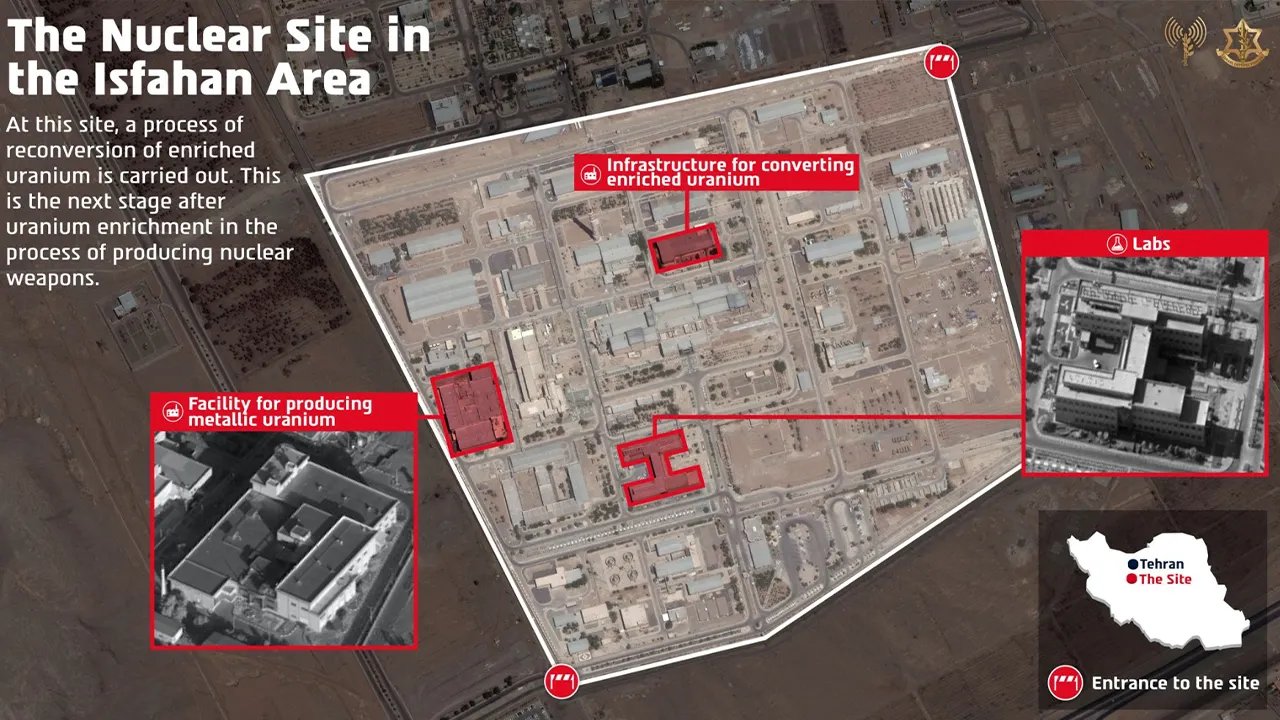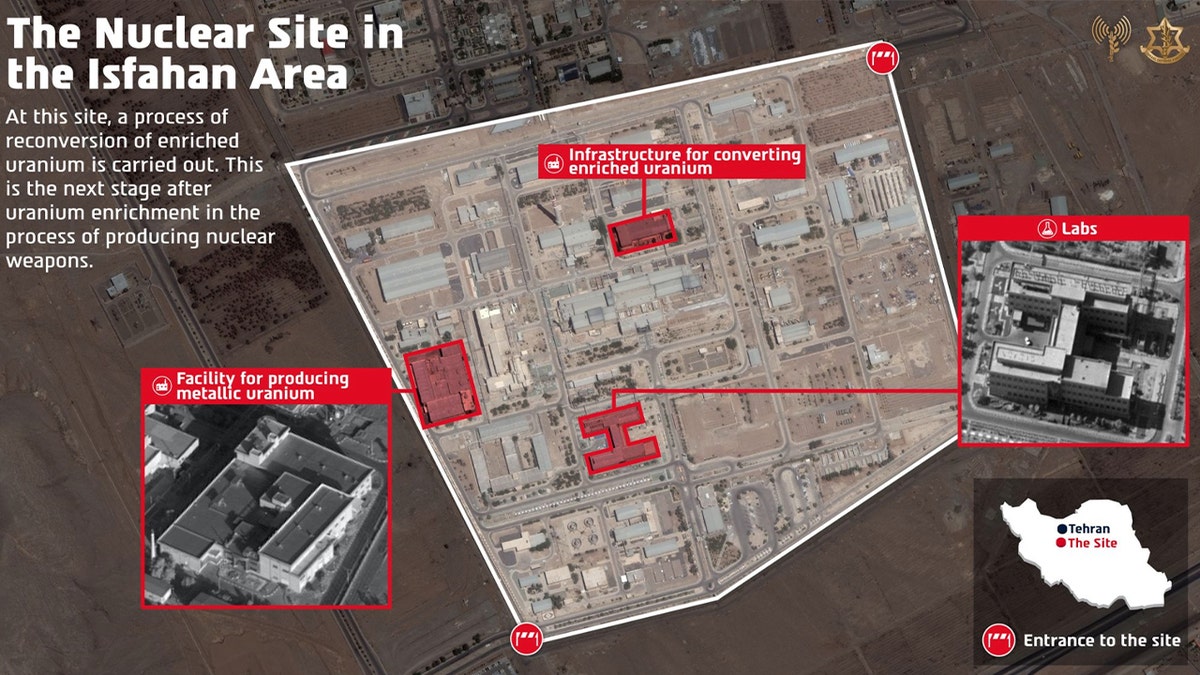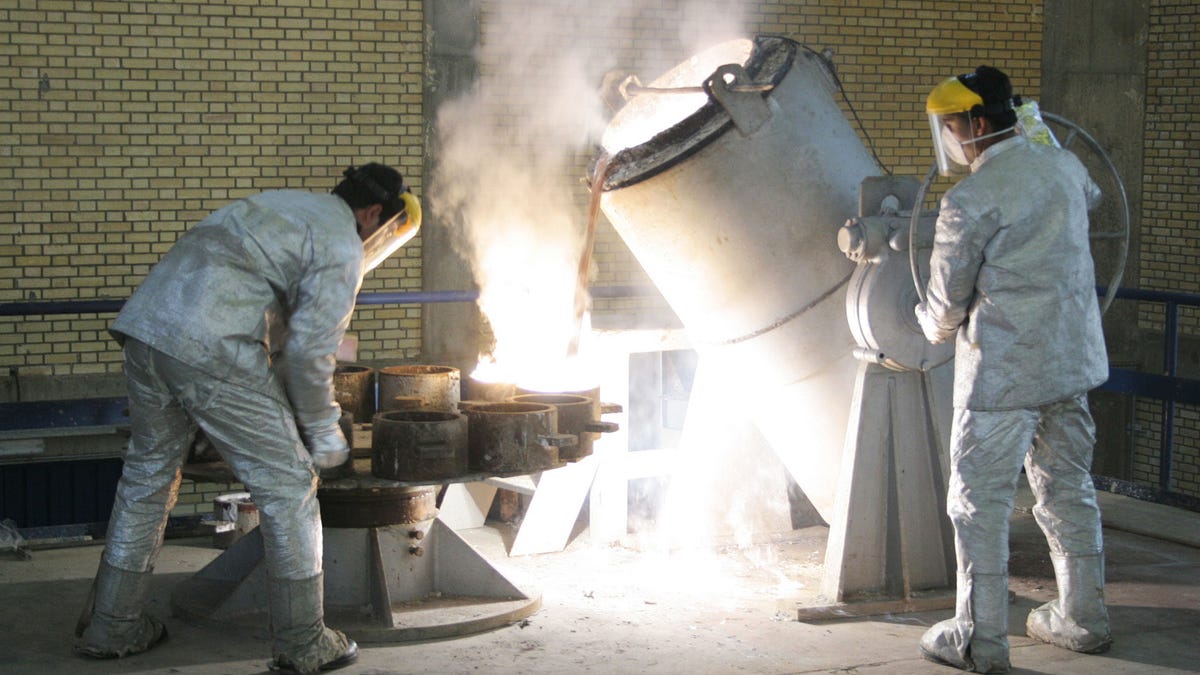INTERNACIONAL
Israel strikes at the heart of Iran’s nuclear ambitions in Isfahan offensive

NEWYou can now listen to Fox News articles!
Israeli Defense Forces (IDF) hit the Isfahan nuclear site in Iran on Friday night, a location where uranium moves beyond enrichment to the «reconversion» process of building a nuclear bomb.
«The strike dismantled a facility for producing metallic uranium, infrastructure for reconverting enriched uranium, laboratories, and additional infrastructure,» the IDF said on Friday.
On Friday evening, video footage posted by Iranian media showed Iranian air defenses attempting to intercept a fresh wave of Israeli attacks on the site, adding it to a list of nuclear sites targeted that includes the key Natanz facility.
HOW CLOSE WAS IRAN TO A NUCLEAR WEAPON BEFORE ISRAEL’S STRIKE ON TEHRAN?
People gather on a hill to watch smoke rising in the distance from an Israeli airstrike in Tehran, Iran, on June 14, 2025. Iran’s foreign minister said the country would respond «decisively and proportionally» to a wave of attacks that Israel launched beginning in the early hours of June 13. The attacks targeted multiple military, scientific and residential locations, as well as senior government officials. (Photo by Khoshiran/Middle East Images/AFP via Getty Images)
The IAEA has confirmed that a nuclear facility in Isfahan was struck by Israel. In a statement on X the IAEA posted that four critical buildings «were damaged in yesterday’s attack, including the Uranium Conversion Facility and the Fuel Plate Fabrication Plant. As in Natanz, no increase in off-site radiation expected.»
«Isfahan’s uranium conversion facility is at the heart of Iran’s quest for domestic fuel cycle mastery,» Behnam Ben Taleblu, senior director at the Foundation for Defense of Democracy’s Iran program, told Fox News Digital.
At Isfahan, uranium is converted into a state suited for gaseous enrichment.
«Crippling this capacity at Isfahan would disconnect the dots between Iran’s diverse nuclear industry and potentially handicap future efforts to prepare uranium for enrichment.»

The IDF Struck the Nuclear Site in the Isfahan Area (IDF)
Direct bombing of a facility that stores nuclear fuel represents a major blow to Iran’s nuclear program – but also risks radioactive spills. Israel avoided hitting Iran’s supply of near-bomb-grade nuclear fuel at Isfahan, the New York Times reported.
«All these developments are deeply concerning,» the International Atomic Energy Agency (IAEA) Director General Rafael Grossi said in a statement on the attacks. «I have repeatedly stated that nuclear facilities must never be attacked, regardless of the context or circumstances, as it could harm both people and the environment.»
Israel has now targeted over 200 sites in Iran in its move to eliminate Iran’s nuclear capability.
IAEA CHIEF CALLS ISRAELI PRESIDENT, REPORTEDLY SAYS IRAN NUCLEAR FACILITY WAS SEVERELY DAMAGED

Technicians work inside of a uranium conversion facility producing unit March 30, 2005, just outside the city of Isfahan, about 254 miles (410 kilometers), south of the capital, Tehran, Iran. The cities of Isfahan and Natanz in central Iran are home to the heart of Iran’s nuclear program. The facility in Isfahan makes hexaflouride gas, which is then enriched by feeding it into centrifuges at a facility in Natanz, Iran. Iran’s President Mohammad Khatami and the head of Iran’s Atomic Energy Organisation Gholamreza Aghazadeh visited the facilities. (Getty Images)
Iranian media reported on Saturday that Israel had struck near the northwestern Tabriz refinery, reporting three missile strikes in locations near western Iran.
The Israeli military said that initial strikes had taken out nine nuclear scientists, in addition to top generals in the Iranian Revolutionary Guard Corps (IRGC) and dozens of others.
Iran’s counter-strikes have killed three Israelis.
Experts have long warned that Iran is weeks away from enriching uranium to a weapons-grade 90%, and Israeli intelligence sources suggest Iran had moved beyond enrichment into the early production phase of a nuclear weapon.
CLICK HERE TO GET THE FOX NEWS APP
The IAEA has warned of Iran’s «rapid accumulation of highly enriched uranium» and said the regime has been opaque about providing details on its use.
INTERNACIONAL
Nuevas imágenes del robo del Louvre: así huyeron los ladrones con el botín millonario en un montacargas

Francia sigue en shock tras el impactante robo en el museo del Louvre, ocurrido el domingo por la mañana. Un grupo de ladrones, vestidos como trabajadores y con la cara cubierta, se llevó ocho objetos valuados en más de 100 millones de dólares pertenecientes a la colección de Napoleón y de los antiguos reyes franceses.
Las nuevas imágenes de las cámaras de seguridad muestran cómo dos de los delincuentes descendieron por la fachada sur del museo, a orillas del Sena, usando un montacargas. Uno de ellos llevaba puesto un chaleco amarillo, simulando ser un operario. En cuestión de segundos, ambos bajaron de la grúa, se subieron a una moto —presuntamente una T-Max— y desaparecieron del lugar.
Leé también: Cuáles son las joyas que fueron robadas en el Louvre y qué puede pasar con ellas, según expertos El montacargas que usaron los ladrones para irrumpir y escapar en el Louvre. (Foto: AFP/Dimitar Dilkoff).
Un golpe relámpago en plena apertura del museo
El robo se produjo minutos después de las 9.30 de la mañana, justo cuando el Louvre abría sus puertas al público. En los videos se observa cómo, mientras los primeros visitantes ingresaban a la Galería de Apolo —una de las salas más espectaculares del museo, donde se exhiben las joyas reales y los diamantes de la corona—, los ladrones actuaban a sus espaldas.
Uno de los delincuentes, oculto detrás de una vitrina y vestido con el chaleco amarillo, utilizó una amoladora angular para romper el cristal blindado. Así, lograron sustraer las piezas y salir sin levantar sospechas.

El momento en el que un turista grabó a uno de los ladrones de las joyas del Louvre. (Video: gentileza TRT World / Foto: Reuters)
Ocho minutos, una amoladora y una moto: así fue el robo perfecto
La banda necesitó apenas ocho minutos para ejecutar el golpe. La rapidez y la precisión con la que actuaron les permitió escapar sin ser detenidos. El collar y los pendientes de esmeraldas de la reina Marie-Louise que fueron robados del Louvre. (Foto: AFP/Stéphane de Sakutin).
El caso reavivó el debate sobre la protección de los tesoros nacionales y la necesidad de reforzar la seguridad en uno de los museos más importantes del mundo.
Leé también: El Museo del Louvre estimó que las joyas robadas valen más de U$S100 millones
El Louvre reconoció que faltan cámaras de seguridad tras el robo
La directora del Louvre, Laurence des Cars, aseguró el miércoles que las alarmas del museo funcionaron durante el espectacular robo de joyas, pero admitió que el sistema de videovigilancia en el exterior es “muy insuficiente”, en su comparecencia ante una comisión en el Senado.
“Hay algunas cámaras perimetrales, pero están obsoletas […] Es muy insuficiente y no cubre claramente todas las fachadas del Louvre. Desgraciadamente, en el lado de la galería de Apolo, la única cámara instalada está orientada hacia el oeste”, y por lo tanto, no cubría el balcón por donde accedieron los ladrones, añadió, en sus primeras declaraciones públicas desde el hurto.
La responsable, que en 2021 se convirtió en la primera mujer en dirigir la pinacoteca, también pidió que se instalara “una comisaría de policía” dentro del establecimiento y sugirió otras medidas “a corto plazo” como “la seguridad de las inmediaciones del Louvre, especialmente en la calzada».
Este robo es “una inmensa herida que nos han infligido”, dijo Des Cars, que presentó su renuncia al gobierno, aunque fue rechazada.
“Una supuesta mudanza”
La investigación “avanza”, aseguró el ministro del Interior, Laurent Nuñez, quien precisó que “más de un centenar de investigadores” están movilizados.
Según la fiscal de París, Laure Beccuau, los delincuentes obtuvieron el vehículo montacargas a través de “un falso alquiler para una supuesta mudanza”. La corona de la emperatriz Eugenia, que fue abandonada por los ladrones. (Foto: AFP/Stéphane de Sakutin).
La fiscal también precisó que el servicio de conservación del Louvre estimó los daños en 88 millones de euros (102 millones de dólares), una suma “extremadamente espectacular” pero que “no es en absoluto paralela ni comparable a los daños históricos”, lamentó.
Los ladrones “no ganarán” ese monto “si tienen la pésima idea de fundir esas joyas”, advirtió.
Francia, Robo, Louvre
INTERNACIONAL
Dems silent on progressive candidate’s Nazi-style tattoo after knocking Hegseth for Christian symbol

NEWYou can now listen to Fox News articles!
Prominent Democrats who were highly critical of Secretary of War Pete Hegseth’s tattoos with crusader symbolism are now keeping silent on a progressive Senate candidate who had a Nazi-style symbol tattooed to his chest.
Sen. Elizabeth Warren, D-Mass., and Sen. Tammy Duckworth, D-Ill., criticized Hegseth for his tattoos, one of which is a Jerusalem cross and another with the Latin phrase «Deus Vult» (God wills it), both of which are associated with the crusades and ancient Christian symbolism.
Following their comments against Hegseth, Fox News Digital reached out to Warren and Duckworth for comment on the ongoing controversy over Maine Senate Democratic candidate Graham Platner having a «Totenkopf,» Nazi «death’s head» symbol tattooed to his chest.
Warren has previously expressed enthusiasm for Platner’s candidacy, telling Politico, «I’m excited to see new people enter the race for the Senate … particularly those who have a strong voice they’re willing to use on behalf of people who are often ignored in the U.S. Senate.»
ARE PETE HEGSETH’S TATTOOS SYMBOLS OF ‘CHRISTIAN NATIONALISM’?
Sen. Elizabeth Warren, D-Mass., left, and Sen. Tammy Duckworth, D-Ill., right, kept silent on progressive Senate candidate Graham Platner’s controversial tattoo. (Ben Margot/AP Photo; WGME via AP; Anna Moneymaker/Getty Images)
Fox News Digital asked whether Warren and Duckworth condemn Platner because of the tattoo and whether they believe he should drop out of the race. Neither immediately responded to Fox News Digital’s request for comment.
During Hegseth’s confirmation hearings, Warren sent him an extensive letter, in which, among other issues, she expressed concern about his «Deus Vult» tattoo.
«You were also removed from President Biden’s inauguration because of concerns that you were an insider threat after reports that your ‘Deus Vult’ tattoo ‘was a Christian expression associated with right-wing extremism,’» Warren wrote. «We cannot have a Defense Secretary whose fellow servicemembers feel concerned enough about to report as a potential insider threat.»
Democrats have continued to give Hegseth a hard time over the tattoos. During a hearing in June, Duckworth accused Hegseth of «blowing through money like my fellow cadets and I did in our first liberty after basic camp. Luckily, I didn’t end up with a questionable tattoo.»
‘MAINE’S MAMDANI’: MAINE GOP CHIEF ISSUES WARNING ABOUT NEW CHALLENGER LOOKING TO OUST SUSAN COLLINS

U.S. Secretary of War Pete Hegseth speaks to senior military leaders at Marine Corps Base Quantico, Va., Sept. 30, 2025. (Andrew Harnik/Pool via Reuters)
Platner, a Marine veteran and progressive endorsed by the likes of Sen. Bernie Sanders, I-Vt., has garnered widespread criticism over a skull-and-crossbones tattoo on his chest that strongly resembles the Totenkopf symbol used by Hitler’s SS forces.
After the controversy erupted, Platner said he got the tattoo in 2007 during a «night of drinking» while on leave in Croatia in the Marine Corps and claimed he did not know its historical associations at the time. He has since covered the image with another tattoo of dogs.
In a video posted to Instagram Wednesday afternoon, Platner elaborated that the design was chosen from a flash tattoo wall while «carousing» with fellow Marines in Split, Croatia.
«We thought it looked cool,» he said.
MAINE DEM SENATE HOPEFUL BACKED BY BERNIE SANDERS APOLOGIZES FOR NAZI-STYLE TATTOO, VOWS TO STAY IN RACE

Sen. Bernie Sanders speaks at a «No Kings» rally in Washington, D.C., Oct. 18. (Fox News Digital/Emma Woodhead)
He claimed he had «lived a life dedicated to anti-fascism, anti-racism and anti-Nazism» and was «appalled» to learn it resembled a hate symbol.
A spokesperson for Sanders shared an Axios interview with the senator in which he said, «I’m not overly impressed by a squad of media running around saying, ‘What do you think about the tattoo on Graham Platner’s chest’» and «between you and me there might be one or two more important issues.»
CLICK HERE TO DOWNLOAD THE FOX NEWS APP
The spokesperson also shared another statement from Sanders in which he said of Platner, «I personally think he is an excellent candidate. I’m going to support him, and I look forward to him becoming the next senator in the state of Maine»
Fox News Digital also reached out to Sanders and Platner’s campaign for comment but did not immediately receive a response.
Fox News Digital’s Jasmine Baehr contributed to this report.
2025 2026 elections coverage,democratic party,pete hegseth
INTERNACIONAL
Dos aviones militares rusos violaron el espacio aéreo de Lituania y provocaron un operativo de la OTAN

Dos aviones de combate de Rusia penetraron en el espacio aéreo de Lituania, país miembro de la OTAN, este jueves alrededor de las 18:00 hora local (15:00 GMT). Según información confirmada por el ejército lituano, los aparatos, un caza Su-30 y un avión cisterna Il-78, cruzaron desde la región de Kaliningrado y recorrieron unos 700 metros en territorio lituano. La irrupción duró aproximadamente 18 segundos.
Las fuerzas armadas lituanas explicaron que las aeronaves realizaban, probablemente, maniobras de entrenamiento de reabastecimiento cuando traspasaron la frontera estatal cerca de Kybartai, al suroeste del país. Tras la detección del incidente por radar, Vilna activó los protocolos de seguridad e informó a sus aliados de la OTAN, la Unión Europea (UE) y al Consejo del Atlántico Norte.
En respuesta inmediata, dos cazas Eurofighter Typhoon españoles, desplegados en la base aérea de Siauliai como parte de la misión de Policía Aérea del Báltico y la operación ‘Centinela Oriental’, despegaron y patrullaron la zona. Un portavoz de la OTAN afirmó que la intervención de los cazas españoles demuestra “la disposición de la OTAN para responder ante cualquier acontecimiento” y su capacidad para garantizar la integridad aérea de sus miembros.
La invasión temporal del espacio aéreo fue calificada como “una severa violación del Derecho Internacional y la soberanía territorial” por el presidente Gitanas Nauseda. En un video difundido en la red social X, el mandatario subrayó que los hechos confirman “la importancia de fortalecer la preparación de la defensa aérea europea”. Además, anunció que Lituania convocaría a representantes de la embajada rusa en Vilna para protestar formalmente contra lo que describió como un “comportamiento imprudente y peligroso”.
Por su parte, la primera ministra Inga Ruginiene declaró en Facebook que “este incidente demuestra una vez más que Rusia se comporta como un Estado terrorista, despreciando el Derecho internacional y la seguridad de los países vecinos”.
“Lituania es segura. Junto con nuestros aliados, cuidamos y defenderemos cada centímetro de nuestro país”, añadió la premier e insistió en que la “situación está completamente bajo control”. Ruginiene también elogió la rápida y coordinada acción de los cazas españoles implicados.
El Ministerio de Defensa ruso negó la incursión.
“Los vuelos se realizaron en estricto cumplimiento de las normas de uso del espacio aéreo sobre territorio ruso. Las aeronaves no se desviaron de su ruta ni violaron las fronteras de otros estados”, declaró en Telegram.
El incidente elevó las tensiones en la zona, en un contexto regional ya sensible por las continuas provocaciones rusas. Según el ministro polaco de Defensa, Wladyslaw Kosiniak-Kamysz, entrevistado por la cadena TVN24, “esto demuestra que la vigilancia es necesaria en todo momento, que Rusia no se está calmando ni retrocediendo”.
Este no es un hecho aislado en la región. El pasado 19 de septiembre, tres aviones militares rusos violaron el espacio aéreo de Estonia durante 12 minutos. La OTAN envió entonces cazas para escoltar a los aparatos hasta su salida. En ese caso, Rusia negó la incursión y acusó a Tallin de carecer de pruebas y de buscar aumentar la tensión entre Oriente y Occidente. Aún antes, más de 20 drones rusos entraron en el espacio aéreo de Polonia; fue la primera vez desde el inicio de la guerra en Ucrania que la OTAN derribó objetivos rusos en defensa de un país miembro.
El general estadounidense responsable del mando militar de la OTAN expresó durante la semana que la firme respuesta aliada frente a las incursiones en Polonia y Estonia parece haber actuado como elemento disuasorio para Moscú, aunque se prevé que Rusia continúe con pruebas a los límites defensivos.
Organizaciones de seguridad y líderes de la UE reconocieron la importancia de fortalecer la defensa aérea europea. El propio Nauseda participó el jueves en una cumbre del Consejo Europeo en Bruselas, donde los líderes de la Unión respaldaron la estrategia ‘Readiness 2030’, orientada a garantizar la capacidad de Europa para defenderse ante cualquier agresión externa.
No hubo comentarios inmediatos por parte de Moscú tras la denuncia lituana. Las autoridades rusas han negado en ocasiones previas su implicación en violaciones similares, acusando a los países bálticos de exagerar o de falsificar pruebas para alimentar la tensión en la región. La OTAN mantiene desplegados grupos de vigilancia aérea permanente en los estados bálticos, a la espera de nuevos acontecimientos.
(Con información de AP, EP y Reuters)
Politics,Europe

 DEPORTE1 día ago
DEPORTE1 día agoUniversidad de Chile vs. Lanús, por la Copa Sudamericana: día, horario y cómo verlo por TV

 CHIMENTOS2 días ago
CHIMENTOS2 días agoAdabel Guerrero confesó de qué famosa está enamorada y que le encantaría tener relaciones: «La China Suárez me sorprendió con su belleza»

 ECONOMIA3 días ago
ECONOMIA3 días agoScott Bessent oficializó el swap con la Argentina y afirmó: “No queremos otro Estado fallido en América Latina”














